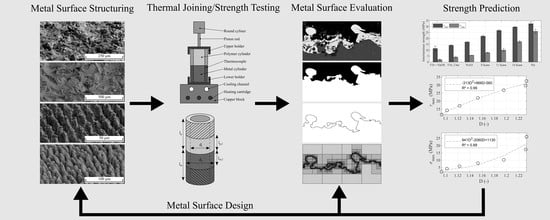Introducing Fractal Dimension for Interlaminar Shear and Tensile Strength Assessment of Mechanically Interlocked Polymer–Metal Interfaces
Abstract
1. Introduction
- A high structure density characterized by densely arranged profile elements with a high aspect ratio;
- The presence of sub-structures on the profile elements;
- The presence of undercuts.
2. Materials and Methods
2.1. Materials
2.2. Surface Pretreatment
2.2.1. Grit Blasting
2.2.2. Thermal Spraying
2.2.3. Laser Structuring
2.3. Butt-Bonded Hollow Cylinder Specimens
2.4. Fractal Dimension
2.5. Surface Roughness
3. Results and Discussion
4. Conclusions
- Interlaminar shear and tensile strength are related to each other. An increase in shear strength corresponds to an increase in tensile strength. Tensile strength prediction from shear strength and vice versa is reasonable for profile element heights within the investigated range (27.5 < Rz < 131).
- Interlaminar strength prediction based on the surface structure is reasonable for profile element heights within the investigated range.
- Fractal dimension is an appropriate, scale-independent measure for describing the surface structure with a mathematical value as it considers structure density, undercuts, as well as sub-structures.
- Tactile measured surface roughness slope is an appropriate measure for coarse structures, but fails for undercut, densely arranged, and small-scaled profile elements, as well profile elements arranged in preferred directions.
- The fracture analysis indicates that the amount of polymer residues on the metal surface is strongly related to the interlaminar strength. Higher interlaminar strength leads to more residues. Shear testing leads to considerably more residues than tensile testing.
- Wetting behavior of the metal surface with polymer must be considered when predicting the interlaminar strength from the surface structure because incomplete wetting lowers the achievable strength in relation to the theoretical potential.
- Laser generated, stochastically distributed pin microstructures led to the highest interlaminar strength of all investigated structuring methods. The profile elements were densely arranged, steep, partially undercut, showed complete wetting with polymer, and had the highest fractal dimension.
Author Contributions
Funding
Acknowledgments
Conflicts of Interest
References
- Amend, P.; Häfner, T.; Gränitz, M.; Roth, S.; Schmidt, M. Effect of Ultrashort Pulse Laser Structuring of Stainless Steel on Laser-based Heat Conduction Joining of Polyamide Steel Hybrids. Phys. Procedia 2016, 83, 1130–1136. [Google Scholar] [CrossRef]
- Zopp, C.; Nestler, D.; Buschner, N.; Mende, C.; Mauersberger, S.; Tröltzsch, J.; Nendel, S.; Nendel, W.; Kroll, L.; Gehde, M. Influence of the cooling behaviour on mechanical properties of carbon fibre-reinforced thermoplastic/metal laminates. In Proceedings of the 3rd International MERGE Technologies Conference (IMTC), Chemnitz, Germany, 21–22 September 2017; Volume 1, pp. 32–43. [Google Scholar]
- Katayama, S.; Kawahito, Y. Laser direct joining of metal and plastic. Scr. Mater. 2008, 59, 1247–1250. [Google Scholar] [CrossRef]
- Bergmann, J.P.; Stambke, M. Potential of Laser-manufactured Polymer-metal hybrid Joints. Phys. Procedia 2012, 39, 84–91. [Google Scholar] [CrossRef]
- Mitschang, P.; Velthuis, R.; Didi, M. Induction Spot Welding of Metal/CFRPC Hybrid Joints. Adv. Eng. Mater. 2013, 15, 804–813. [Google Scholar] [CrossRef]
- Liu, F.; Liao, J.; Nakata, K. Joining of metal to plastic using friction lap welding. Mater. Des. 2014, 54, 236–244. [Google Scholar] [CrossRef]
- Haberstroh, E.; Sickert, M. Thermal Direct Joining of Hybrid Plastic Metal Components. KMUTNB Int. J. Appl. Sci. Technol. 2014, 7, 29–34. [Google Scholar] [CrossRef]
- Wagner, G.D.; Balle, F.; Eifler, D. Ultrasonic Welding of Aluminum Alloys to Fiber Reinforced Polymers. Adv. Eng. Mater. 2013, 15, 792–803. [Google Scholar] [CrossRef]
- Pan, Y.; Wu, G.; Huang, Z.; Li, M.; Ji, S.; Zhang, Z. Effect of surface roughness on interlaminar peel and shear strength of CFRP/Mg laminates. Int. J. Adhes. Adhes. 2017, 79, 1–7. [Google Scholar] [CrossRef]
- Saborowski, E.; Dittes, A.; Steinert, P.; Lindner, T.; Scharf, I.; Schubert, A.; Lampke, T. Effect of Metal Surface Topography on the Interlaminar Shear and Tensile Strength of Aluminum/Polyamide 6 Polymer-Metal-Hybrids. Materials 2019, 12, 2963. [Google Scholar] [CrossRef] [PubMed]
- Amend, P.; Pfindel, S.; Schmidt, M. Thermal Joining of Thermoplastic Metal Hybrids by Means of Mono- and Polychromatic Radiation. Phys. Procedia 2013, 41, 98–105. [Google Scholar] [CrossRef]
- Steinert, P.; Dittes, A.; Schimmelpfennig, R.; Scharf, I.; Lampke, T.; Schubert, A. Design of high strength polymer metal interfaces by laser microstructured surfaces. In IOP Conference Series: Materials Science and Engineering; IOP Publishing: Bristol, UK, 2018; Volume 373, pp. 1–9. [Google Scholar]
- Lindner, T.; Saborowski, E.; Scholze, M.; Zillmann, B.; Lampke, T. Thermal Spray Coatings as an Adhesion Promoter in Metal/FRP Joints. Metals 2018, 8, 769. [Google Scholar] [CrossRef]
- Kleffel, T.; Drummer, D. Investigating the suitability of roughness parameters to assess the bond strength of polymer-metal hybrid structures with mechanical adhesion. Compos. Part B Eng. 2017, 117, 20–25. [Google Scholar] [CrossRef]
- Chen, C.Q.; Scott, W.; Barker, T.M. Effect of metal surface topography on mechanical bonding at simulated total hip stem-cement interfaces. J. Biomed. Mater. Res. 1999, 48, 440–446. [Google Scholar] [CrossRef]
- Amada, S.; Yamada, H. Introduction of fractal dimension to adhesive strength evaluation of plasma-sprayed coatings. Surf. Coat. Technol. 1996, 78, 50–55. [Google Scholar] [CrossRef]
- Mahnken, R.; Schlimmer, M. Simulation of strength difference in elasto-plasticity for adhesive materials. Int. J. Numer. Methods Eng. 2005, 63, 1461–1477. [Google Scholar] [CrossRef]
- Saborowski, E.; Scholze, M.; Lindner, T.; Lampke, T. A numerical and experimental comparison of test methods for the shear strength in hybrid metal/thermoplastic-compounds. In IOP Conference Series: Materials Science and Engineering; IOP Publishing: Bristol, UK, 2017; Volume 181. [Google Scholar]
- Saborowski, E.; Kießling, R.; Dittes, A.; Paczkowski, G.; Ihlemann, J.; Lampke, T. Determination of the strength of polymer-metal interfaces under mixed mode loading using butt-bonded hollow cylinders. Int. J. Adhes. Adhes. 2019, 89, 30–39. [Google Scholar] [CrossRef]
- Baburaj, E.; Starikov, D.; Evans, J.; Shafeev, G.; Bensaoula, A. Enhancement of adhesive joint strength by laser surface modification. Int. J. Adhes. Adhes. 2007, 27, 268–276. [Google Scholar] [CrossRef]
- Mandelbrot, B.B. The Fractal Geometry of Nature; Freeman: New York, NY, USA, 1983. [Google Scholar]
- Schneider, C.A.; Rasband, W.S.; Eliceiri, K.W. NIH Image to ImageJ: 25 years of image analysis. Nat. Methods 2012, 9, 671–675. [Google Scholar] [CrossRef] [PubMed]
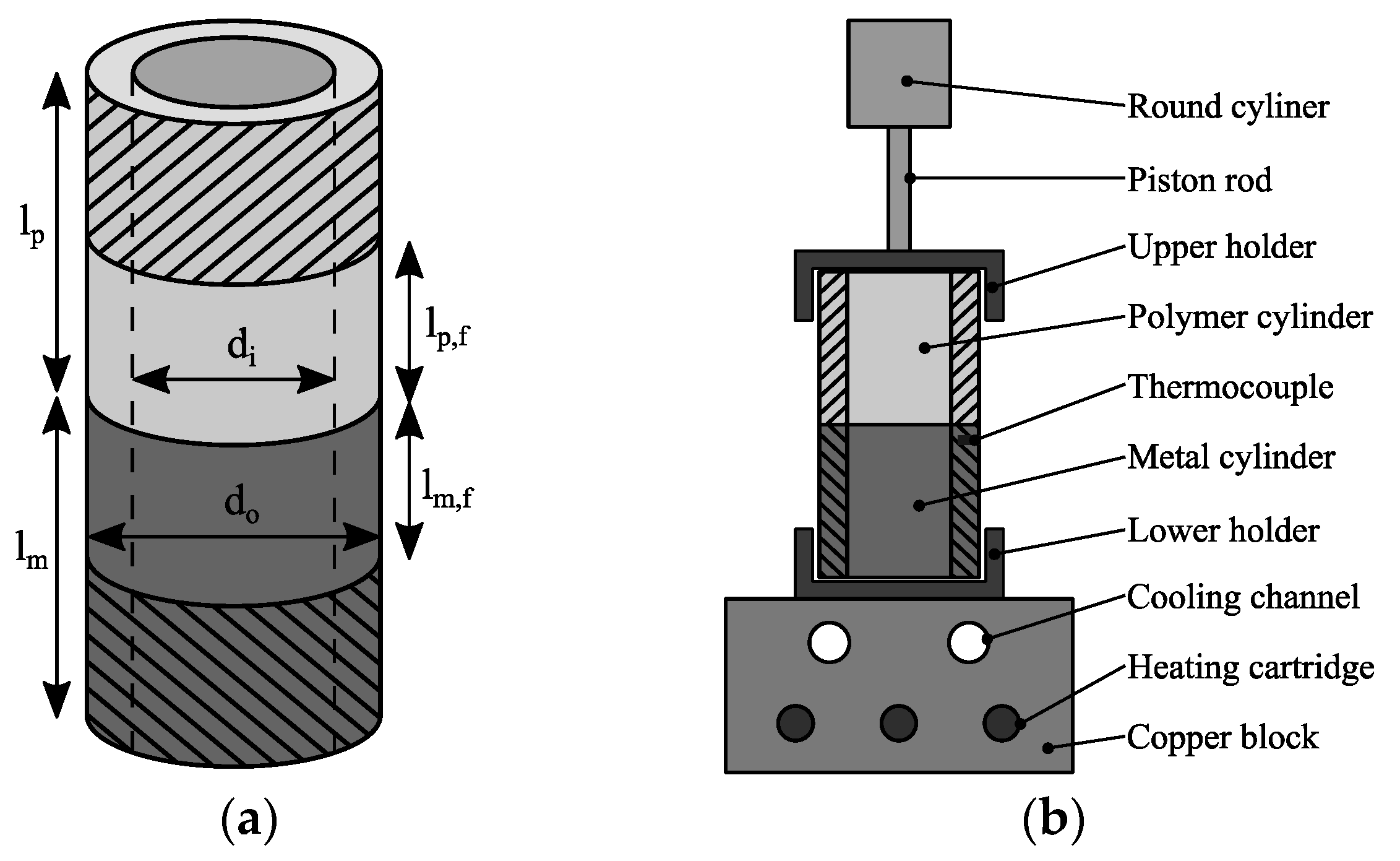






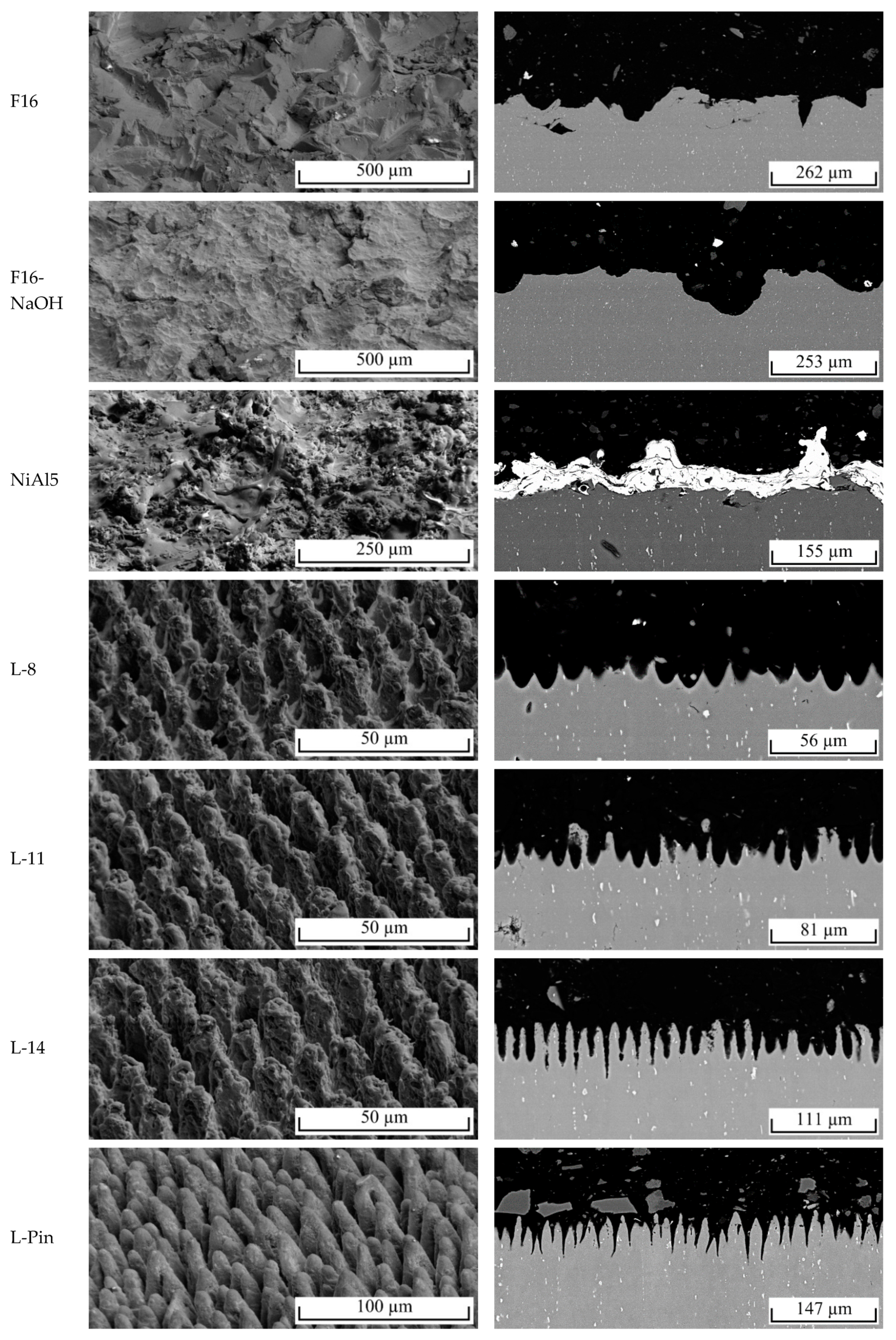
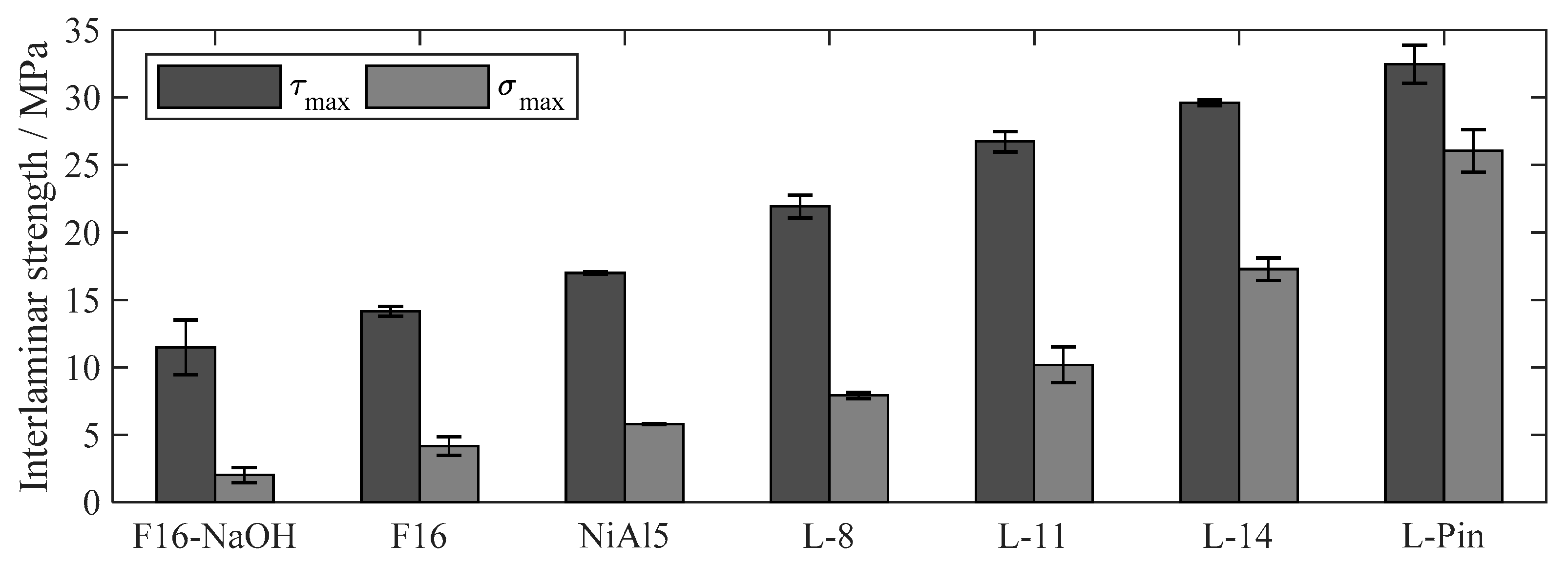
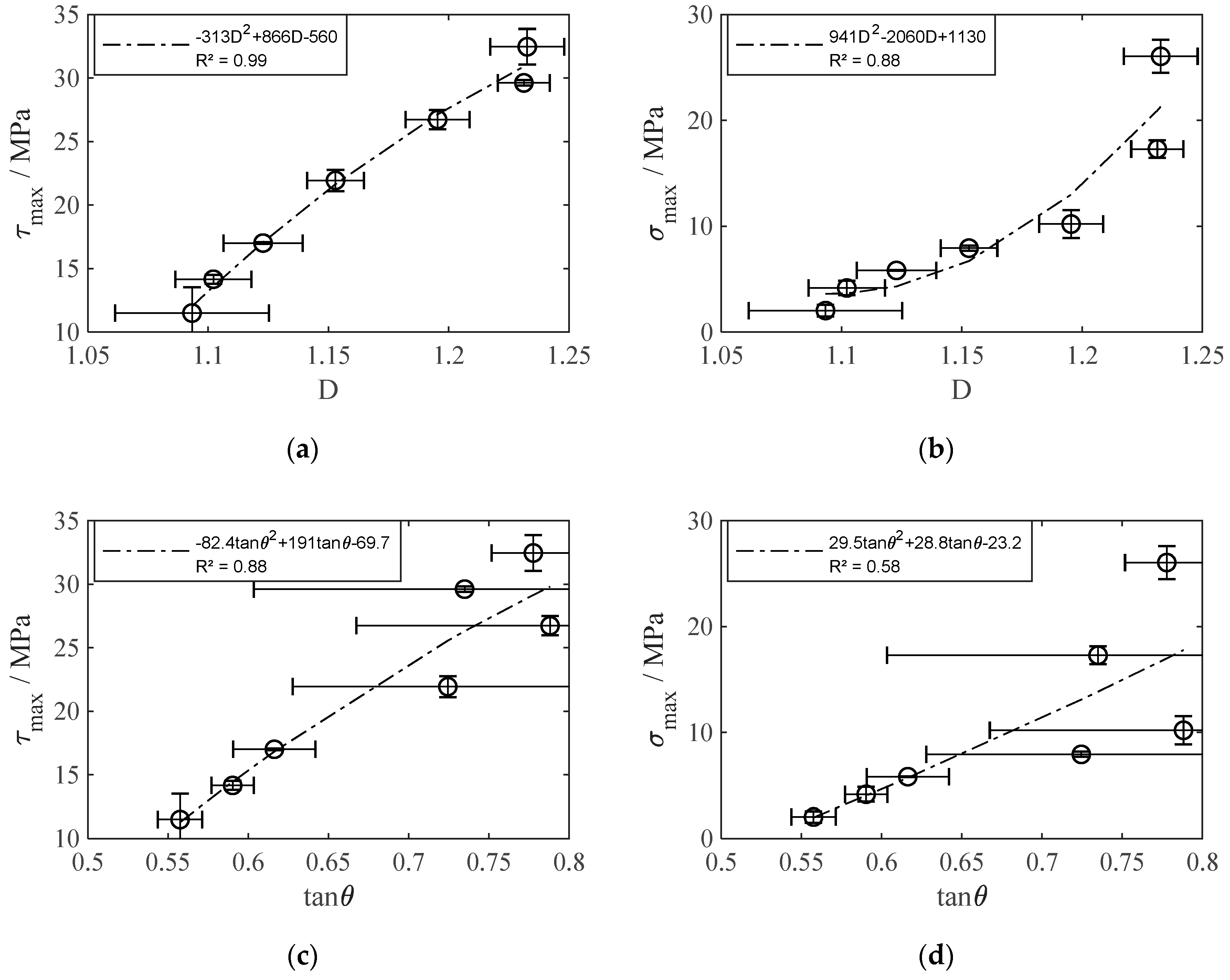
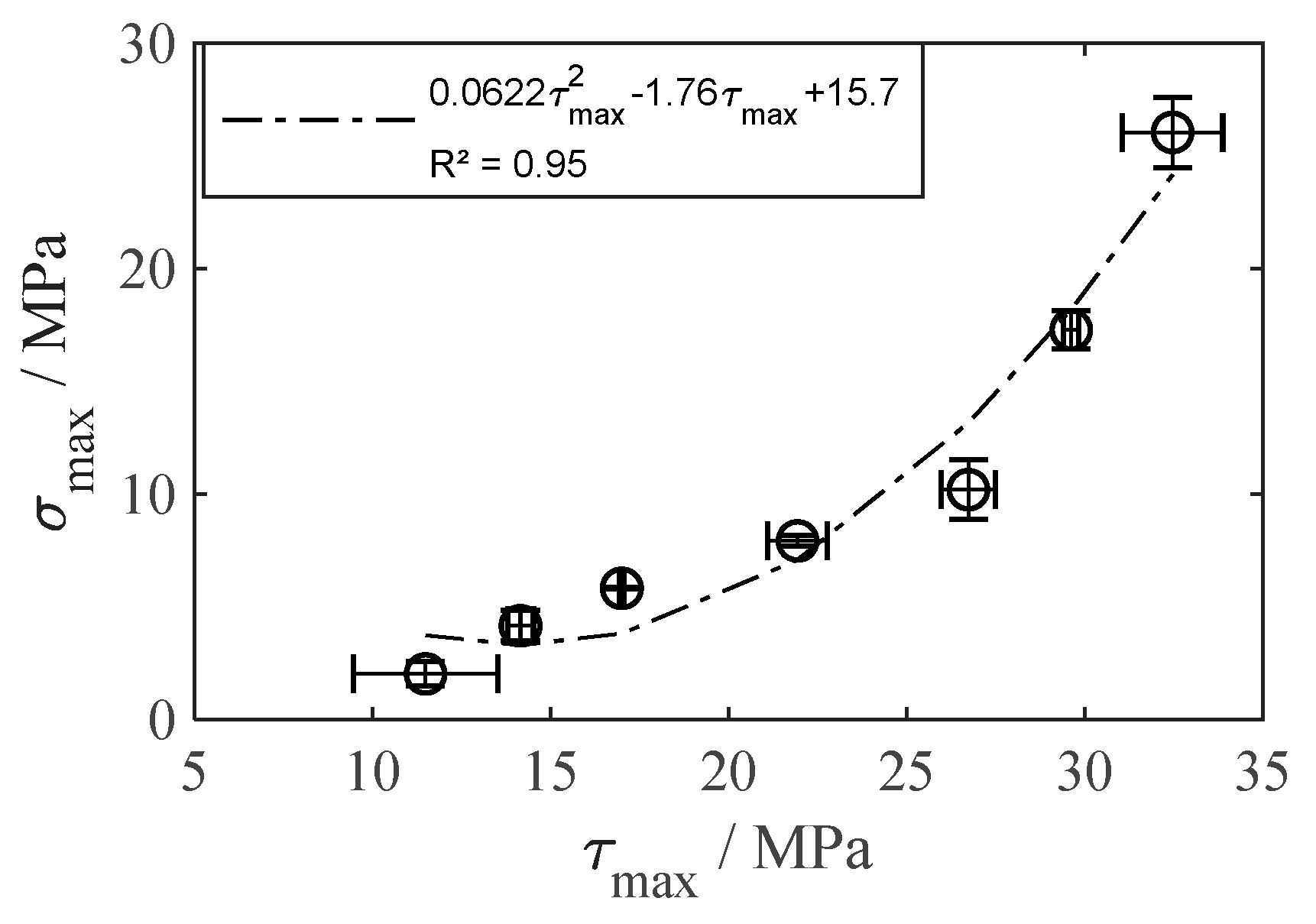

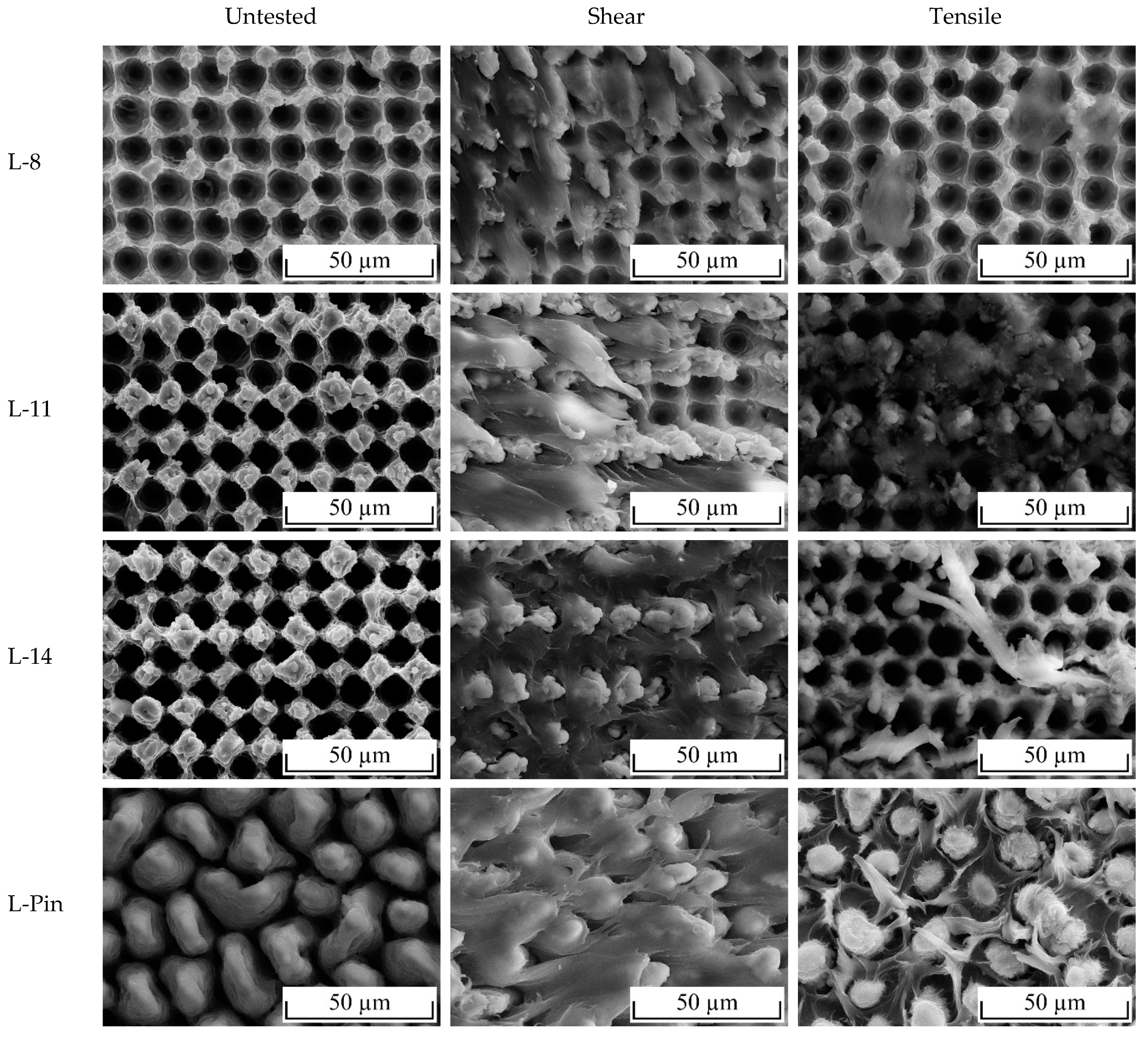
| EN AW-6082 | PA 6 (Humid) | |
|---|---|---|
| Density [kg/m³] | 2.7 | 1.14 |
| Young’s modulus [MPa] | 70,000 | 1800 |
| Poisson’s ratio [—] | 0.34 | — |
| Yield strength [MPa] | 260 | 60 |
| Ultimate strength [MPa] | 310 | — |
| Elongation to failure [%] | 7 | 200 |
| Melting temperature [K] | 933 | 496 |
| Thermal expansion coefficient [10−6/K] | 23.4 | 70 |
| Thermal conductance [W/(m·K)] | 170–220 | 0.23 |
| Specific heat [J/(kg·K)] | 898 | 1700 |
| Treatment | Rz/µm | tan θ | D | τmax/MPa | σmax/MPa |
|---|---|---|---|---|---|
| F16 | 131 ± 8 | 0.590 ± 0.013 | 1.102 ± 0.016 | 14.2 ± 0.4 | 4.16 ± 0.69 |
| F16-NaOH | 124 ± 9 | 0.557 ± 0.014 | 1.093 ± 0.032 | 11.5 ± 2.0 | 2.02 ± 0.55 |
| NiAl5 | 80.4 ± 4.2 | 0.616 ± 0.004 | 1.123 ± 0.016 | 17.0 ± 0.1 | 5.81 ± 0.03 |
| L-8 | 32.2 ± 0.4 | 0.724 ± 0.025 | 1.153 ± 0.012 | 21.9 ± 0.8 | 7.92 ± 0.24 |
| L-11 | 31.0 ± 1.1 | 0.788 ± 0.096 | 1.195 ± 0.013 | 26.7 ± 0.8 | 10.2 ± 1.3 |
| L-14 | 27.5 ± 2.2 | 0.735 ± 0.121 | 1.231 ± 0.011 | 29.6 ± 0.2 | 17.3 ± 0.8 |
| L-Pin | 45.6 ± 1.2 | 0.778 ± 0.026 | 1.233 ± 0.015 | 32.5 ± 1.4 | 26.0 ± 1.6 |
© 2020 by the authors. Licensee MDPI, Basel, Switzerland. This article is an open access article distributed under the terms and conditions of the Creative Commons Attribution (CC BY) license (http://creativecommons.org/licenses/by/4.0/).
Share and Cite
Saborowski, E.; Steinert, P.; Dittes, A.; Lindner, T.; Schubert, A.; Lampke, T. Introducing Fractal Dimension for Interlaminar Shear and Tensile Strength Assessment of Mechanically Interlocked Polymer–Metal Interfaces. Materials 2020, 13, 2171. https://doi.org/10.3390/ma13092171
Saborowski E, Steinert P, Dittes A, Lindner T, Schubert A, Lampke T. Introducing Fractal Dimension for Interlaminar Shear and Tensile Strength Assessment of Mechanically Interlocked Polymer–Metal Interfaces. Materials. 2020; 13(9):2171. https://doi.org/10.3390/ma13092171
Chicago/Turabian StyleSaborowski, Erik, Philipp Steinert, Axel Dittes, Thomas Lindner, Andreas Schubert, and Thomas Lampke. 2020. "Introducing Fractal Dimension for Interlaminar Shear and Tensile Strength Assessment of Mechanically Interlocked Polymer–Metal Interfaces" Materials 13, no. 9: 2171. https://doi.org/10.3390/ma13092171
APA StyleSaborowski, E., Steinert, P., Dittes, A., Lindner, T., Schubert, A., & Lampke, T. (2020). Introducing Fractal Dimension for Interlaminar Shear and Tensile Strength Assessment of Mechanically Interlocked Polymer–Metal Interfaces. Materials, 13(9), 2171. https://doi.org/10.3390/ma13092171






